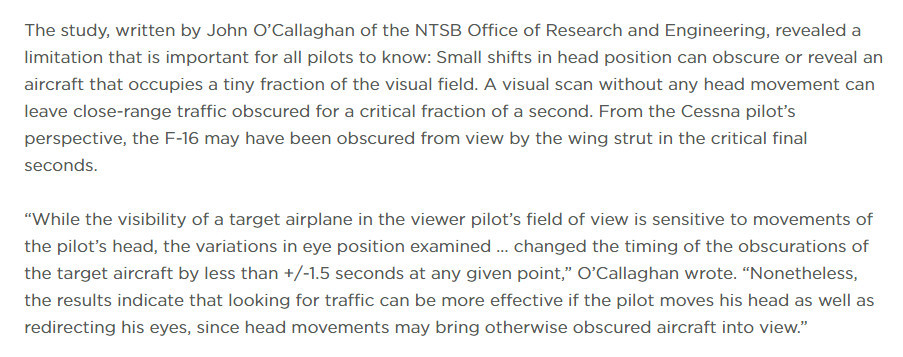the vast majority of airprox reports are in class G
I had a smiley there, Mike:

What I meant is that if you “set yourself up for one” (e.g. by flying at 1500ft in certain places) you will get so many that you will not be so keen on filing reports. And that’s assuming you never actually approach any aerodrome circuit on a sunny weekend.
I am still looking for the ADS-B answers. Maybe an F35 has ADS-B?
I had a smiley there, Mike:
Doh! Sometimes I’m blinded by the obvious……
UK Tornadoes don’t have TCAS. And I’m told poor cockpit vision.
What you see may not be what you think you see
Today, flying along at a very unusually level level for me  of 2300ft, I get a TCAS warning, 1.5nm ahead (the TAS605 does not work beyond that range at the 12 o’clock bearing) 100ft above, and heading in the opposite direction. It turned out to be a C152 or similar, more or less where I looked for it.
of 2300ft, I get a TCAS warning, 1.5nm ahead (the TAS605 does not work beyond that range at the 12 o’clock bearing) 100ft above, and heading in the opposite direction. It turned out to be a C152 or similar, more or less where I looked for it.
As I was watching it pass by, quite close (maybe 100m), a white Lancair (maybe a 320 or similar size) flies by underneath the Cessna, in the same direction as the Cessna but much faster, and a lot closer to me, with his transponder turned off…. heading straight for the Southampton Class D 
I’ve noticed in these situations that regardless of the method used to spot the other aircraft, it rarely seems to see you or take any evasive action, even when you’re staring eyeball to eyeball. It makes me wonder how many times I may have done the same thing.
If you roll the aircraft on its side and pull the throttle you lose altitude very fast. I’ve done it in this circumstance.
Glad you missed them both!
Why is head movement required for an effective visual scan for traffic?

As regards the actual case there, I find it hard to understand why 40 seconds wasn’t long enough for the F16 to avoid the Cessna. Maybe it is a typo – 4 seconds? Also what about the F16’s radar?
Anyway, this is in the USA and it is about time we had some CAAs here in Europe admitting that visual scan is not a good way to detect traffic.

Peter wrote:
Anyway, this is in the USA and it is about time we had some CAAs here in Europe admitting that visual scan is not a good way to detect traffic.
FLARM is “mandatory” on gliders most places, even though no CAAs have mandated it’s use. In Norway and Austria the national gliding clubs are the CAAs, so it actually is mandatory. In motorized GA, mid airs is a much less problem than in gliders, but it still would be nice to see where others are. Strange thing, towing gliders without FLARM feels like flying blindfolded 
Peter wrote:
As regards the actual case there, I find it hard to understand why 40 seconds wasn’t long enough for the F16 to avoid the Cessna. Maybe it is a typo – 4 seconds?
You mean:
The F-16 pilot flying alone over South Carolina was told 40 seconds before the collision that traffic was straight ahead, two miles away.
?
It says he was given traffic information, not that he saw it. If you’re told of traffic at 12 o’clock 2 miles, what do you do? Which way do you turn?
From that point of view, the last paragraph you quote is interesting. Most traffic awareness systems are encouraged as an “aid to visual acquisition”. That’s the first time I’ve seen a suggestion that such a display might be used to manoeuvre to increase separation before visual acquisition.
That’s the first time I’ve seen a suggestion that such a display might be used to manoeuvre to increase separation before visual acquisition.
That is exactly how I would use mine. Climb, in most cases. OCAS, so you can do what you like; I go up a few hundred feet.
To do no avoidance before getting visual is daft because most of the time one never gets visual, so the system would be wasted.
I think the “aid to visual acquisition” is a legal disclaimer to avoid liability. It’s the same thing as every handheld GPS and every tablet app saying it is for VFR only and not to be used for anything to do with flying 
You also need pretty good eyesight and be looking at just the right place to see a Cessna at 2 miles.
bookworm wrote:
That’s the first time I’ve seen a suggestion that such a display might be used to manoeuvre to increase separation before visual acquisition.
But this is exactly what radar controllers do: They will use their display, which is not significantly different from modern onboard systems in this respect, to increase separation while the aircraft are looking out for each other.
Peter wrote:
Climb, in most cases.
If they have no other indication and you are not at an exact collision course, i.e. some laterall movement is present, a radar controller will turn you towards the current position of the other traffic. Simply because this is the only place where he is not going to be in the near future. If it looks like a collision course, I would turn to the right, as by the book. Otherwise I would do it like the controller, turn to where I see him now. Climb or descend? No. Überlingen is not forgotten yet.